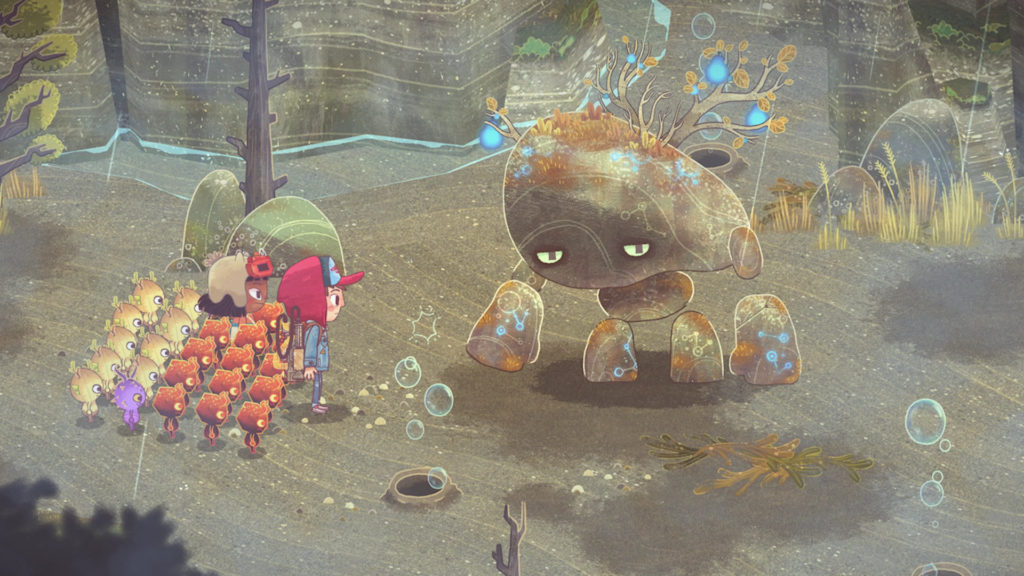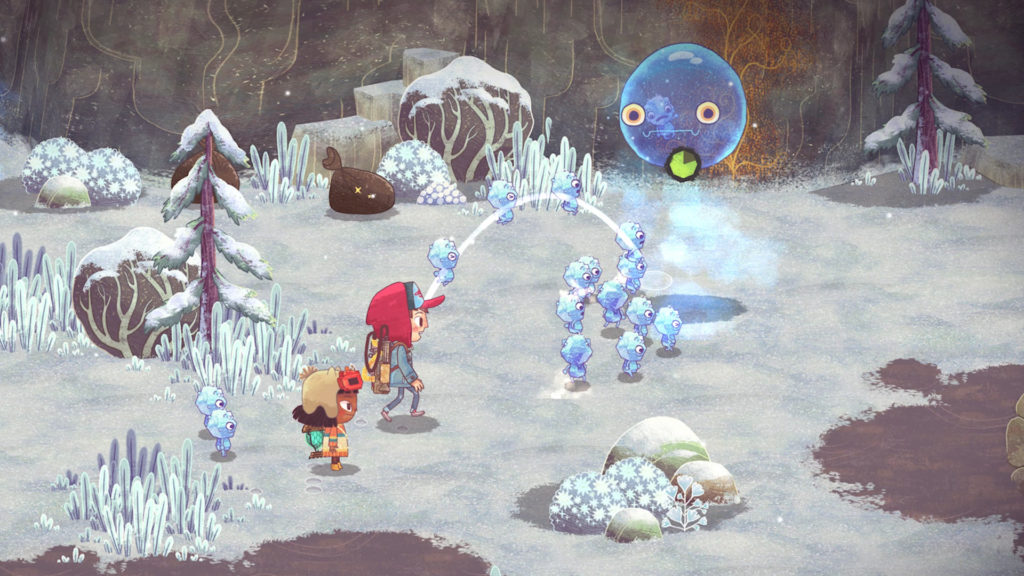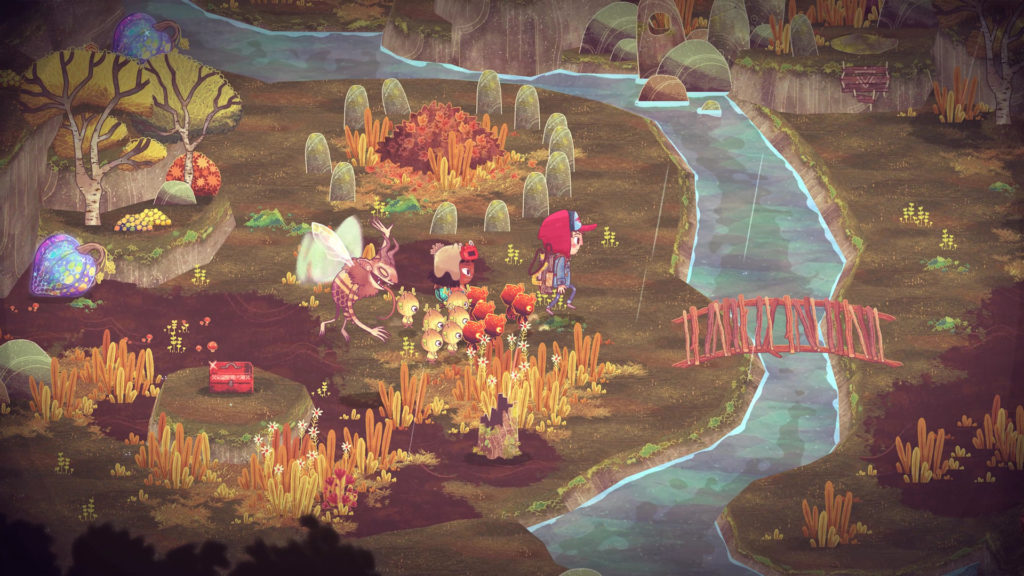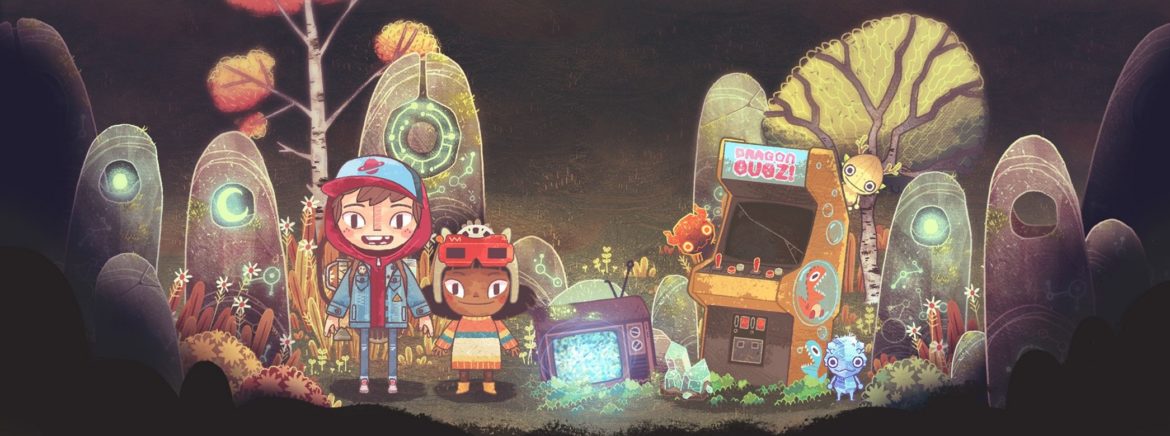The Wild at Heart opens with scenes that suggest trauma and broken homes. Its protagonist, Wake, has lost his mother and is running away from a spectral father figure slumped in front of the TV and surrounded by beer bottles. You’ll read from that what you will. His younger friend Kirby has a neglectful single parent, although we see nothing of her home life. The two friends have agreed to run away together and live in the nearby woods. Things immediately diverge from that plan as the guardians of the Deep Woods draw Wake into their world. Kirby, somehow, soon follows, and the two friends meet up not long into the game.
The game’s developers recognise that comparisons with Nintendo’s Pikmin series are inevitable and they acknowledge the relationship. It’s a comparison that it’s senseless to try and avoid because there is much here that can be traced back to Miyamoto’s cult classic series, and talking about The Wild at Heart is aided by using Pikmin as a reference point. I’m getting this out of the way now, because from here I am going to casually reference Pikmin staples – if you lack familiarity with that series you will be just fine reading this, and also you should play Pikmin – and this will help in highlighting where The Wild at Heart champions its own voice, style and mechanics.
(If you are a fan of the Pikmin series, you’ll be aware that there’s very little else that scratches that itch. Pikmin games are rare, as the series has never sold as well as the other Miyamoto golden geese. The Overlord series managed two games and an expansion, and they are slightly Pikmin-like. Beyond that I’m only aware of the forthcoming Tinykin and Little King’s Story, a Wii game I’ve never played. This scarcity means hungry Pikmin fans may jump on any game which offers comparable fare. See, the comparison is good for The Wild at Heart!)

The Wild at Heart’s art style works for me. I couldn’t tell you what that style is but I can tell you that it is immensely charming and features a cast of lovingly animated and designed characters. Even most of the enemies are cute. Certainly your spritelings – the friendly herd beasties who are the player’s most effective tools – are adorable and distinct. The latter is vital as they each fulfil their own roles. Yellows are fast workers who can ignore poison fumes; reds are immune to fire and can ignite thorny bushes; blues are immune to ice damage and can create walkways across shattered ice; purples can smash crystals and stick to rope-and-pulley barrels; the final type, the ‘lunalings’, gain in strength at night and can create light that suppresses The Never.
Ah, we’ve not yet talked about The Never. This is the game’s big bad. The Deep Woods exist to contain it, and the guardians of both are called the Hermetic Order of the Verdant Shield. Unfortunately the Greenshields, as they’re known for short, have forgotten that name along with their own and much else besides. Things are getting worse, and that’s why they’ve decided to bring in some outside help, in the form of a traumatised twelve-year old boy.
The story goes to some fun places. There aren’t any major surprises and, if you’re the type who thinks stuff through or just someone who talks to every NPC repeatedly, you’ll see the game’s twist coming. Even so, it hardly matters. This is a narrative that delivers thanks to writing that is playful and funny and warm characters who are pleasant to spend some time with, rather than through convoluted plotting and contrived surprise.
The basic story is this: the Greenshields are losing their grip, both on the Deep Woods that protect the outside world from The Never, and on what remains of their memories, which are fed upon by The Never. They’re also scattered and lost, and your first real task is to find the lost Greenshields and send them home. After that you need some artefacts, and from there it’s on to the big showdown. We don’t spend ages going back and forth or chasing a lot of macguffins. There are, I suppose, just enough macguffins. Sometimes you need other macguffins to access the important macguffin, but at least in those cases you’re doing stuff like finding flute parts for a friendly Where The Wild Things Are monster or finding rotten oysters to make a raccoon dragon throw up. Wholesome shit, my friends.
The Greenshields are a friendly bunch and most of them have some utility, too. One guy offers area maps, another has bounties for you, another rewards you for finding objects around the map – these are a bit like the ‘artefacts’ you may remember collecting in the Pikmin series, and their descriptions by a befuddled Greenshield is a fun tribute to the archaeological efforts of Captain Olimar and friends – another has rewards if you find her cats (yes!), and still another is a shopkeeper. You’ll check in with them all regularly except, perhaps, 20/20, who you’ll forget has bounties up until the postgame when you decide to spend a few hours relaxing and hunting achievements. Or maybe you’re better than me.

Speaking of bounties, combat plays its part in the experience. Your tactics are largely a matter of selecting the appropriate spriteling to counter your opponent and tossing them into action. There is no ‘charge’ command to rush everything in your herd at an enemy, and few threats will live long enough to toss the entire herd at. For the most part combat is a change of pace and a palette cleanser; there’s not much to it but there does not need to be.
The bulk of the gameplay comes in the form of environmental puzzles, which you must use some combination of your available spriteling types and your two player characters’ abilities to solve. Wake has his home-made ‘gustbuster’ – a vacuum cleaner – and Kirby finds a magic lamp. Both fulfil similar purposes when it comes to gathering items and controlling spritelings, but each also has unique environmental capabilities that you’ll learn as the game progresses.
For the most the puzzles were fun to work out and few had me stumped for long, whilst none felt insurmountable. When I felt genuinely blocked it was clear that it was because I did not yet have access to a particular spriteling needed to bypass a particular obstacle. On only one occasion did I give up and look online to see how to reach an area; it turned out this non-essential area required using a potion I’d never used before and did not use again afterwards. Similarly, there were a few points where I was puzzled as to what I might have been doing wrong. In these cases what I was missing was in the text I had not yet read in Book (the game’s cute name for the ancient tome collating the wisdom of the Greenshields, such as it is). This contains information on some of the more obscure abilities your spritelings possess, as well as tips for dealing with enemies. You should read Book every so often. It never overdoes the amount of text, delivering the information you need alongside just enough flavour.
(I recently played The Ascent, a rather different game which I like a lot despite its numerous technical flaws, and that has big blocks of text for each area and faction you encounter. All of the text is flavour and has nothing to do with anything you will do in the game, beyond ‘be in a grimdark cyberpunk hellcity’. My eyes began to glaze over every time I looked at the lore pages. Anyway. The Ascent has its own merits, and maybe I’ll write about those another time.)
So, that’s The Wild At Heart! It’s a charming, relaxing, consistently fun experience that’s well-paced and rarely frustrating. The lack of frustration is significant. I’m a big fan of the Pikmin series but its strict daily time limits and dangerous monsters – which can wipe out huge groups of Pikmin in one strike – mean that sometimes events rapidly spiral downwards, a setback which can feel truly awful. I experienced few if any such moments in The Wild at Heart, for all that staying out after sundown can be rather deadly. And for all that I think the Pikmin games are great family experiences, I feel like The Wild at Heart succeeds in offering a comparable yet unique experience with less friction. Its opening narrative may seem a bit heavy for very young kids, but within five minutes you’ll be exploring a fantasy world full of cute characters anyway. That’s something we can all enjoy.
(The Wild at Heart was developed by Moonlight Kids, a games studio in the US with a distributed team. The game was released in May 2021 and was published by Humble Games. It’s currently available on Game Pass, where I played it, as well as purchasable via Steam, the Humble Store, GOG and the Xbox Store.)


